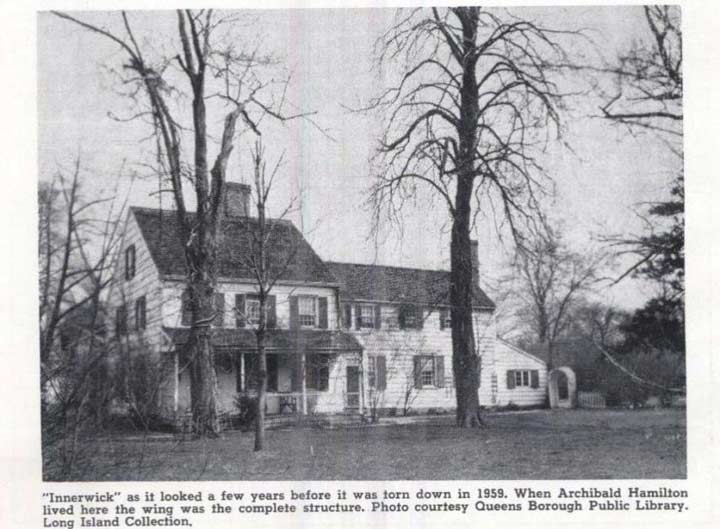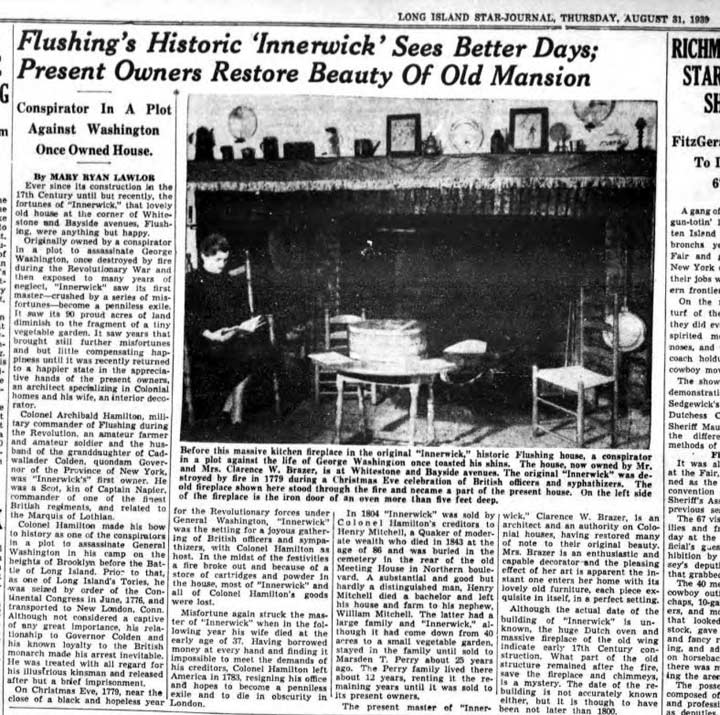By SERGEY KADINSKY
Forgotten New York correspondent
With the ongoing public debate going on regarding the future of the Steinway Mansion, whose yard space has been reduced and is being developed into warehouses, it is an ideal opportunity to look back at another old-time Queens dwelling that did not make it…

Innerwyck was the second-oldest residential structure in the borough after the Bowne House. It stood at the corner of Union Street and Bayside Avenue, two ancient roadways that predate the numbered street grid of Queens.
Built around 1670, it played a vital role during the American Revolution. Burned in a Christmas 1779 fire that was blamed on local patriots, it was quickly rebuilt by its loyalist owner, Colonel Archibald Hamilton. As with its owner, the building’s name has Scottish origins. Hamilton was born in 1735 near Innerwick Castle in the East Lothian region of Scotland. His wife was Alice Colden, granddaughter of Cadwallader Colden, New York’s last colonial governor, whose Spring Hill estate stood on the site of present-day Mount Hebron Cemetery.
In 1783, Hamilton and other loyalists fled as the British departed the former colony. A 1939 article by Long Island Star-Journal describes him as a ringleader in a failed plot to assassinate George Washington.

In 1804, the home was purchased by the Mitchell family, whose name was later bestowed on the Mitchell-Linden Gardens apartments that now stand across Union Street from the former mansion. The Mitchells farmed their property until 1921.
An optimistic Long Island Star-Journal article from October 1945 describes the restoration of the house to its pre-revolution appearance. “Landmark in flushing,” the headline shouts. But back then, there was no landmarks law in the city. The City’s Department of Records also visited the house in that month, taking photos of historical reenactors sitting by the fireplace. That month, the home celebrated the tercentenary of Flushing.
Its last owners were architect and philatelist Clarence Wilson Brazer and his wife Esther, a prolific interior decorator, who lovingly restored the structure together. She died in November 1945 and her husband followed in 1956. In 1959, the house was unceremoniously demolished and replaced with a squat two-story structure containing medical offices.
Most of its tenants these days are from South Korea, but looking at the plain modernist architecture, the building looks more North Korean than southern. So is there any trace of Innerwyck still standing? If so, perhaps it’s on the northeastern side of the medical office on Bayside Avenue, where a remnant of a stone gate stands as an apparent architectural folly.
That’s all that’s left of Innerwyck, a storied structure that graced Flushing with its beauty from 1670 to 1959.
Sergey Kadinsky is the author of the upcoming Hidden Waters of New York City, to be released in March 2015 on Countryman Press.
12/11/15
